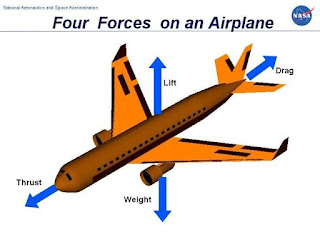HUMAN FLIGHT | HOW IS IT POSSIBLE?
Airplanes are engineering marvels. It has been through a lot of modifications before becoming what it is today. Let us understand how they are able to fly.
First, to know, there are four forces acting on an airplane. They are lift, weight, thrust, and drag. Two forces allow the plane to fly and the other two don't. Here is a picture to make it clear.
The thrust force helps in the forward motion of the aircraft. This force is generated from the aircraft's engines. The lift force helps in the flight of the aircraft. It is generated by the wings of the aircraft.
Lift Force
The airplane's wings have a unique shape that helps it to produce the lift force to lift off into the sky.
This unique shape allows for faster airflow at the top than at the bottom. This fast-moving air when hitting the ground helps in the flight.
Thrust Force
The airplane's engines produce the thrust force. This helps in the forward fast movement of the aircraft.
More powerful engines are developed these days that produce up to 127,000 pounds of thrust.
Although thrust and lift are the forces that are needed for the flight of the airplane, the other two forces weight and drag are equally important.
Drag Force
The drag force is the force acting in the opposite direction to the thrust force. The drag force is primarily through the air resistance.
Weight Force
We know that all objects exert a force perpendicularly downwards. It is the weight force. Airplanes also exert weight force downwards.
In order for an airplane to fly, it is obvious that the thrust force should be greater than the drag force and the lift force should be greater than the weight force.
The drag and weight forces are necessary to slow down the aircraft in certain conditions. For example, During landings.
There are many parts included in the wings, the horizontal and vertical stabilizers, etc. But these four forces are the primary ones that help an aircraft to fly. Other topics will be discussed in later posts.
An important principle of mechanics is that any object that's at rest can keep
at rest, unless acted upon by some force, and any object that's moving can
continue moving at a gradual speed unless acted upon by a force.
This statement is as a result a straightforward statement of what's called Newton’s 1st Law of Motion.
There are unit 2 kinds of forces that will act on a body.
They are:
(1) outwardly applied mechanical forces like a straightforward push or pull
(2) the supposed body forces like those caused by the attraction of gravity
and magnetism and electricity fields.
External forces relevant to the mechanics of flight embody the thrust created
by a reaction-propulsion engine or a propeller, and therefore the drag resistance created by movement through the air.
A less obvious external force is that of reaction.
A simple example of a reactive force is that happens once an associate degree object is placed on a fixed surface.
The table produces an associate degree upward reactive force that precisely balances
the weight. the sole body force that's of interest within the mechanics of flight is
the force thanks to the attraction of gravity, which we all know merely because of the weight of the article.
Forces (of no matter type) area unit measured within the units of newtons (N) within the metric system or pounds-force (lbf) within the Imperial or Federal systems.
There is one explicit power that we tend to are completely familiar with; it's alluded to as the power in light of gravity.
We tend to all perceive that any item positioned near the planet is pulled in towards it. What's perhaps less acknowledged is that this can be a shared fascination-like attraction.
the planet is pulled in towards the article with essentially as decent a power in light of the fact that the item is pulled in towards the planet. All articles are equally pulled in towards each other.










0 Comments